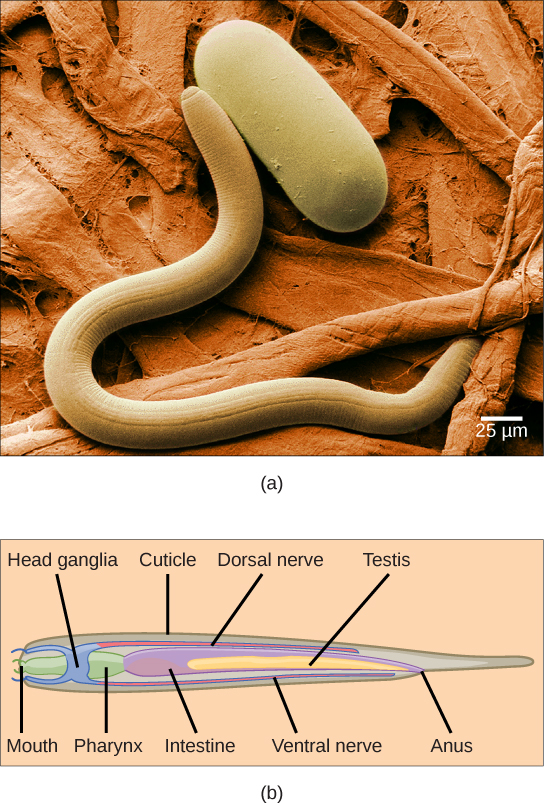| << Chapter < Page | Chapter >> Page > |
The cuticle of Nematodes is rich in collagen and a carbohydrate-protein polymer called chitin, and forms an external “skeleton” outside the epidermis. The cuticle also lines many of the organs internally, including the pharynx and rectum. The epidermis can be either a single layer of cells or a syncytium, which is a multinucleated cell formed from the fusion of uninucleated cells.
The overall morphology of these worms is cylindrical, as seen in [link] . The head is radially symmetrical. A mouth opening is present at the anterior end with three or six lips as well as teeth in some species in the form of cuticle extensions. Some nematodes may present other external modifications like rings, head shields, or warts. Rings, however, do not reflect true internal body segmentation. The mouth leads to a muscular pharynx and intestine, which leads to a rectum and anal opening at the posterior end. The muscles of nematodes differ from those of most animals: They have a longitudinal layer only, which accounts for the whip-like motion of their movement.

In nematodes, specialized excretory systems are not well developed. Nitrogenous wastes may be lost by diffusion through the entire body or into the pseudocoelom (body cavity), where they are removed by specialized cells. Regulation of water and salt content of the body is achieved by renette glands, present under the pharynx in marine nematodes.
Most nematodes possess four longitudinal nerve cords that run along the length of the body in dorsal, ventral, and lateral positions. The ventral nerve cord is better developed than the dorsal or lateral cords. All nerve cords fuse at the anterior end, around the pharynx, to form head ganglia or the “brain” of the worm (which take the form of a ring around the pharynx) as well as at the posterior end to form the tail ganglia. In C . elegans , the nervous system accounts for nearly one-third of the total number of cells in the animal.
Nematodes employ a variety of reproductive strategies that range from monoecious to dioecious to parthenogenic, depending upon the species under consideration. C . elegans is a monoecious species and shows development of ova contained in a uterus as well as sperm contained in the spermatheca. The uterus has an external opening known as the vulva. The female genital pore is near the middle of the body, whereas the male’s is at the tip. Specialized structures at the tail of the male keep him in place while he deposits sperm with copulatory spicules. Fertilization is internal, and embryonic development starts very soon after fertilization. The embryo is released from the vulva during the gastrulation stage. The embryonic development stage lasts for 14 hours; development then continues through four successive larval stages with ecdysis between each stage—L1, L2, L3, and L4—ultimately leading to the development of a young male or female adult worm. Adverse environmental conditions like overcrowding and lack of food can result in the formation of an intermediate larval stage known as the dauer larva.

Notification Switch
Would you like to follow the 'Biology' conversation and receive update notifications?